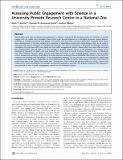Files in this item
Assessing public engagement with science in a university primate research centre in a national zoo
Item metadata
| dc.contributor.author | Bowler, Mark Timothy | |
| dc.contributor.author | Buchanan-Smith, Hannah M | |
| dc.contributor.author | Whiten, Andrew | |
| dc.date.accessioned | 2012-04-16T16:01:07Z | |
| dc.date.available | 2012-04-16T16:01:07Z | |
| dc.date.issued | 2012-04-04 | |
| dc.identifier | 19324405 | |
| dc.identifier | 5d27ac96-9253-4427-9d19-a966676145c2 | |
| dc.identifier | 84859308924 | |
| dc.identifier.citation | Bowler , M T , Buchanan-Smith , H M & Whiten , A 2012 , ' Assessing public engagement with science in a university primate research centre in a national zoo ' , PLoS One , vol. 7 , no. 4 , e34505 . https://doi.org/10.1371/journal.pone.0034505 | en |
| dc.identifier.issn | 1932-6203 | |
| dc.identifier.other | ORCID: /0000-0003-2426-5890/work/65014012 | |
| dc.identifier.uri | https://hdl.handle.net/10023/2560 | |
| dc.description.abstract | Recent years have seen increasing encouragement by research institutions and funding bodies for scientists to actively engage with the public, who ultimately finance their work. Animal behaviour as a discipline possesses several features, including its inherent accessibility and appeal to the public, that may help it occupy a particularly successful niche within these developments. It has also established a repertoire of quantitative behavioural methodologies that can be used to document the public's responses to engagement initiatives. This kind of assessment is becoming increasingly important considering the enormous effort now being put into public engagement projects, whose effects are more often assumed than demonstrated. Here we report our first attempts to quantify relevant aspects of the behaviour of a sample of the hundreds of thousands of visitors who pass through the ‘Living Links to Human Evolution Research Centre’ in Edinburgh Zoo. This University research centre actively encourages the public to view ongoing primate research and associated science engagement activities. Focal follows of visitors and scan sampling showed substantial ‘dwell times’ in the Centre by common zoo standards and the addition of new engagement elements in a second year was accompanied by significantly increased overall dwell times, tripling for the most committed two thirds of visitors. Larger groups of visitors were found to spend more time in the Centre than smaller ones. Viewing live, active science was the most effective activity, shown to be enhanced by novel presentations of carefully constructed explanatory materials. The findings emphasise the importance and potential of zoos as public engagement centres for the biological sciences. | |
| dc.format.extent | 1342265 | |
| dc.language.iso | eng | |
| dc.relation.ispartof | PLoS One | en |
| dc.subject | QL Zoology | en |
| dc.subject.lcc | QL | en |
| dc.title | Assessing public engagement with science in a university primate research centre in a national zoo | en |
| dc.type | Journal article | en |
| dc.contributor.sponsor | The Wellcome Trust | en |
| dc.contributor.institution | University of St Andrews. School of Psychology and Neuroscience | en |
| dc.contributor.institution | University of St Andrews. Institute of Behavioural and Neural Sciences | en |
| dc.contributor.institution | University of St Andrews. ‘Living Links to Human Evolution’ Research Centre | en |
| dc.contributor.institution | University of St Andrews. Centre for Social Learning & Cognitive Evolution | en |
| dc.identifier.doi | 10.1371/journal.pone.0034505 | |
| dc.description.status | Peer reviewed | en |
| dc.identifier.grantnumber | 094440/Z/10/Z | en |
This item appears in the following Collection(s)
Items in the St Andrews Research Repository are protected by copyright, with all rights reserved, unless otherwise indicated.

